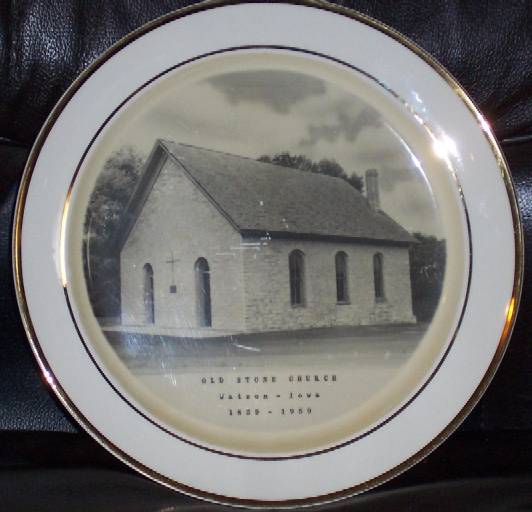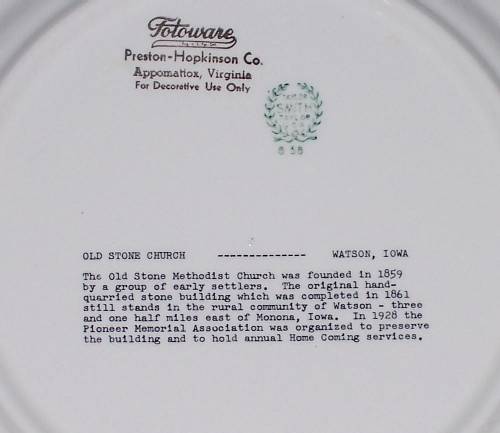Watson - Last August the Old Stone
church observed its 110th anniversary. The church,
located three miles northeast of Monona and just
north of the village of Watson, was incorporated by
"the Methodist Episcopal church of the Yellow
River and Clayton Mission in Linton township,
Allamakee county" August 11, 1859.
Services were held when visiting ministers were
available or by lay members at the Plank schoolhouse
north of Watson. In the fall of 1859, a planning
committee met and one acre of land on which the
church was to be built was purchased from J.B. and
Elizabeth Sutter for the sum of $10.
Stone for the church was quarried, and the church was
completed in the summer of 1862. In 1930 the church
was officially closed. In 1927 former members met and
formed a Pioneer Memorial Church Association to hold
annual memorial meetings. Meetings were held annually
at the church since Aug. 8, 1929. The woman who kept
those meetings alive, Clara M. Sutter, died in
September after the 110th anniversary.
Wendell Baskerville of Monona sent a pamphlet telling
of Miss Sutter's thoughts about the church. Portions
of the pamphlet follow:
"Our first house was built in 1863-1864 so close
to the church that in summer one could hear the
preachers roll out the sermons about hell fire and
what would happen to sinners. Our home became a
sanctuary for those who had walked the long trail and
needed a cup of cold water or a foot bath. It was
then that mother always had a teakettle full of
water, a basin, and a towel. None could afford to
wear the precious leather shoes for mere walking, so
bare feet needed washing before the home-knit
stockings could be put on. Mother often told of a
young couple who walked through the meadow, washed
their feet, then went over in the church and were
married -- barefoot, by the Rev. Plank.
"Each member took the church key for one month
and kept the church area clean, built fires and
shoveled the snow. Few had clocks, and the road was
long, so many times people came to our house to wait
for someone to open the church. Mother decided she
would take the key for Grandma Thias, Grandpa Muth
and Grandma Krueger. Finally she did all the janitor
work for 25 years. In the later years she was paid
$25.00 per year. That was her church money. One
preacher wanted each man to give a tenth of his
income. Grandma Krueger said she would give what the
eggs, laid on Sunday, would bring. She told us that
it seemed as though those hens just laid around on
weekdays so they could lay more on Sunday!
"When the roads became better, people drove to
church. Because wagons were high, and women heavy to
unload, the men built a platform with steps. the
women could step out and walk down. One Sunday,
Grandma Koch's hoopskirt caught on the wagon brake
and [she] hung there until some men ran and stopped
the horses, and others got Grandma untangled. It was
some time before everyone calmed down enough to
listen to the sermon.
"Flowers were not allowed in church because they
were distracting, but when Grandma Koch died, mother
took a bouquet. she said "The Lord made flowers,
so why not use them to show our sympathy to the
family!"
"In those days if no carpenter was free to make
a coffin, the handiest man in the neighborhood made
it, painted it, or covered it with a black cloth. I
remember when a little Bohemian baby died, Uncle Bass
Rupp made the coffin, barely three feet long. Aunt
Lis lined it with part of a quilt. There was no
priest near, so she read the Bible, Grandpa Sutter
made a prayer, Uncle Bass dropped the three shovels
of dirt, I cried, and that was that.
"When Grandma (Mrs. Charles) Renzienhausen died
I couldn't understand why she couldn't talk to me.
All the pictures were draped in black mosquito
netting and, as was the custom, the clock was stopped
when she died, not to be started again until after
the funeral. I couldn't keep my eyes off Mary and
Louise in their long black dresses with crepe veils
reaching to the floor, which was the custom of the
times. The men wore black arm bands -- for a full
year.
"Few people had clothes fit for burial, so the
neighbor women often sat up all night to make a
shroud, to cover the upper part of the body, as there
was only a small glass in the coffin cover. The
coffin was hauled in the best wagon of the community,
with the black horses going at a slow walk. I
remember once when the horses were allowed to trot.
"Yah! They were so glad to get rid of him, they
trotted the horses!"
"Oh yes, there were happy times too, singing
school and camp meetings, and programs. My very first
recollection of the church was the Christmas before I
was two. Cousin Clara Plank Hass had taught me to say
"Glory to God in the highest, peace on earth,
good will to mankind, Amen!" I had a new white
dress with a ruffle. There was a blue ribbon sash,
and mother kept saying, "Piddy do sit still till
I comb your hair!" as she made sausage curls
around her finger. Clara lifted me to the top of the
sunday School stand, beside the big Christmas tree
with flickering candles, popcorn string, toys, and
one doll. After I said my piece, I must have gone to
sleep, because I remember nothing more. People there
must have been, but I was conscious of us two and
that glorious tree.
"Then came later Christmas trees. If my nose is
flat, I am sure it is because it has been pressed
against our north window to get the first sight of
the big boys coming over the hill with the Christmas
tree that was so long that the sled was coupled out
to the farthest length and still the top was dragging
on the ground. They'd let me stand around while they
trimmed it, because they needed me to run errands.
Then came the sacks of candy, nuts, oranges, apples,
peanuts and the big wooden pail of candy! Oh, boy,
that was worth waiting for! It's a good thing
everything was counted, because no matter how sleepy
we were, every sack was emptied and pieces counted!
Such were the ways of our times. There were no bells
to ring out the glad tidings of Christmas, but oh the
jungle of sleighbells as horses pranced in the cold
frosty air!"
~Cedar Rapids Gazette,
November 30, 1969
~contributed by S. Ferrall
![]()

